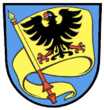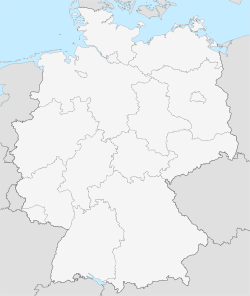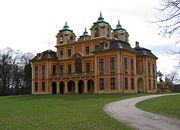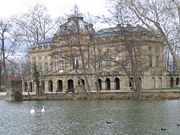Ludwigsburg
| Ludwigsburg | |
| Coat of arms | Location |
 |
 |
| Administration | |
| Country | Germany |
|---|---|
| State | Baden-Württemberg |
| Admin. region | Stuttgart |
| District | Ludwigsburg |
| Mayor | Werner Spec |
| Basic statistics | |
| Area | 43.33 km² (16.7 sq mi) |
| Elevation | 293 m (961 ft) |
| Population | 87,280 (30/12/2006) |
| - Density | 2,014 /km² (5,217 /sq mi) |
| Other information | |
| Time zone | CET/CEST (UTC+1/+2) |
| Licence plate | LB |
| Postal codes | 71634–71642 |
| Area code | 07141 |
| Website | www.ludwigsburg.de |
Ludwigsburg is a city in Germany, about 12 km (7 miles) north of Stuttgart's city center, near the river Neckar. It is the capital of the Ludwigsburg District (its largest city having at present ca 87,000 inhabitants), and belongs to the Stuttgart Region in the Administrative region (Regierungsbezirk) of Stuttgart.
Contents |
History
The middle of Neckarland, in which Ludwigsburg lies, was settled in the Stone age and in the Bronze age. Numerous archaeological finds from the city and the surrounding area remain from the time when it was settled by the Celts.
Toward the end of the 1st century, the Romans occupied the region. They pushed the Limes further to the east around 150, and controlled the region until 260, when the Alamanni occupied the Neckarland. Also the Alamanni settlement is proven by grave finds in the city today.




Ludwigsburg originated in the beginning of the 18th century (1718 - 1723) by the building of the largest Baroque castle in Germany, Ludwigsburg Palace, under Duke Eberhard Ludwig von Württemberg. Originally the Duke planned only one pleasure-palace, which he began building in 1704. However, the example of other Fürsts (or Princes) woke in him a desire: the establishment of a city through which to project his absolutist power. The Baroque hunting- and pleasure-palaces became Favorite (1713 - 1728), and the Seeschloss Seeschloss (Lake-palace) Monrepos (1764 - 1768) besides. (See Barockerlebnis in external links for further details.)
In the years between 1730 and 1800, the royal place of residence changed back and forth several times between Stuttgart and Ludwigsburg. In 1800, Württemberg was occupied by France under Napoleon Bonaparte and was forced into an alliance with France. In 1806 the Kurfürst (Prince-Elector) Friedrich became the king of Württemberg by Napoleon's grant. In 1812 in Ludwigsburg, the Württembergish army was raised for Napoleon's Russian campaign. The majority of the soldiers did not survive it.
One famous person to come out of Ludwigsburg during this period was Friedrich Schiller. Karl Eugen, Duke of Württemberg, enrolled the youth in the Karlsschule Stuttgart (an elite military academy he had founded) in 1773, where Schiller eventually studied medicine. The Duke was very demanding of his students, and Schiller's childhood was a lonely and unhappy one, but he was greatly enriched by the excellent education he received. It was there that he wrote his first play, Die Räuber (The Robbers), about a group of naïve revolutionaries and their tragic failure.
In 1921 Ludwigsburg became the largest garrison in southwest Germany. In 1926 in the course of the building of the north south powerline, the large transformer station Ludwigsburg-Hoheneck, which still exists today, was built, which still represents another central junction in electricity mains of Baden-Württemberg to this day.
In World War II the city suffered moderate destruction (compared with other German cities). The people had 1,500 dead to mourn. It was also the site of the prisoner-of-war camp Stalag V-A from October 1939 till April 1945. After the end of the war there was a large Displaced persons camp which housed several thousand mainly Polish Displaced Persons until about 1948.
For about 45 years after the war the U.S. military maintained Pattonville, a large housing area including a high school, east of Ludwigsburg. In 1956 the tradition of the German garrison town was taken up again by the Bundeswehr, Germany's federal armed forces.
On October 5th, 1957 the first 380kV-powerline in Germany between the transformer station Ludwigsburg-Hoheneck and Rommerskirchen went into service.
In 1966 the Pädagogische Hochschule (Teaching College) and the Staatliche Sportschule Ludwigsburg (State Sports School) were opened.
2004 is the 300th birthday of Residenzschloss Ludwigsburg, celebrated by the opening of the Baroque Gallery and the Ceramic Museum in Residenzschloss.
In 1991 the national film school Filmakademie Baden-Württemberg was established in Ludwigsburg.
Politics
In the local council the following parties or groups are represented:
- Christian Democratic Union, 13 councillors
- Free Voters Union, 9 councillors
- Social Democratic Party, 8 councillors
- The Greens, 5 councillors
- Free Democratic Party/LUBU, 3 councillors
- Republican Party, 2 councillors
Economy
Local Businesses
- GdF Wüstenrot, Bausparkasse
- Beru AG, automotive supplier
- Getrag GmbH, automotive supplier
- Mann+Hummel Gmbh, manufacturer of automotive filtration products
Public institutions
Educational institutions
- Filmakademie Baden-Württemberg, internationally renowned film school
- Pädagogische Hochschule Ludwigsburg
Sister cities
 - Montbéliard (France) since 1950
- Montbéliard (France) since 1950 - Caerphilly (Wales, United Kingdom) since 1960
- Caerphilly (Wales, United Kingdom) since 1960 - Eupatoria (Ukraine) since 1990
- Eupatoria (Ukraine) since 1990 - Saint Charles, Missouri (USA) since 1995
- Saint Charles, Missouri (USA) since 1995
City sections
- Eglosheim
- Grünbühl
- Hoheneck with a therapeutic and thermal bath, opened in 1907
- Neckarweihingen
- Oßweil
- Pflugfelden
- Poppenweiler
- Weststadt
People
- Carl Maria von Weber and Friedrich Silcher wrote music in Ludwigsburg.
- Horst Köhler, current Federal President of Germany and previous managing director of the International Monetary Fund (IMF) grew up in Ludwigsburg.
Sons and daughters of the city
- Charles Pfizer (1824-1906), chemist and founder of Pfizer Inc.
- Wilhelm Groener (1867-1939), soldier and politician
- Caesar von Hofacker (1896-1944), soldier and German Resistance member
- Justinus Kerner (1786-1862), writer and physician
- Eduard Mörike (1804-1874), poet and theologian
- Karl Ludwig von Phull (1757-1826), general
- Christian Friedrich Daniel Schubart (1739-1791), poet
- Tony Schumacher (1848-1931), author of children's books
- David Friedrich Strauß (1808-1874), theologian and writer
- Friedrich Theodor Vischer (1807-1887), theologian, professor, and politician
- Reinhard von Werneck (1757-1842), soldier and director of Munich's Englischer Garten
Print references
- Andrea Hahn: Ludwigsburg, Stationen einer Stadt, Andreas Hackenberg Verlag, Ludwigsburg 2004, ISBN 3-937280-02-2
- Gernot von Hahn, Friedhelm Horn: Ludwigsburg, Stadt der Schlösser und Gärten, Medien-Verlag Schubert, Stuttgart 1998, ISBN 3-929229-55-2
- Bruno Hahnemann: Ludwigsburg. Stadt - Schlösser - Blühendes Barock, Verlag Ungeheuer + Ulmer, Ludwigsburg 1979
- on the sidelines, Frederick Forsyth: The Odessa File (ISBN 0-553-27198-9)
External links
- Stadt Ludwigsburg, Internet site of the City of Ludwigsburg.
- Barockerlebnis, palaces and museums in Ludwigsburg.
- Tourism Information about Ludwigsburg.
- Ludwigsburg travel guide from Wikitravel
- Ludwigsburg at the Open Directory Project
|
|||||||